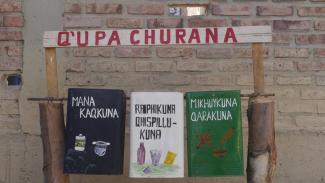Primary schools
Bilingual education
 Vierecke
Vierecke
“Our school system has constantly produced illiterates, who are stigmatised for life as ignorant indios and second-class citizens. This has created a group with no roots, people who feel at home in neither the indigenous nor the dominant culture.” That is how linguist Vidal Arratía of Cochabamba’s San Simón University sums up the situation.
In Bolivia, where 60 % of the population belong to indigenous groups, the early 1970s saw mounting protest against a school system imposed from outside. In the Altiplano, the Aymara took education into their own hands. “Many Aymara felt that schools took their children away from them because schools taught different values, not ours,” Arratía explains. “We wanted a school curriculum that would teach our children to appreciate our culture.”
Therefore intercultural bilingual education was developed, and this model also results in better Spanish and foreign language skills. “Moreover, recent studies show how important intercultural bilingual education is for promoting a sense of identity and encouraging young indigenous people to learn,” Arratía says. That, in his view, is the most important aspect of all.
The concept suites present-day Bolivia well. President Evo Morales has radically transformed the political environment. Since 2009, the new constitution defines the country as a “plurinational state” and recognises 37 official languages at the national level. At regional level, there is at least one indigenous official language in every region.
In December 2010, a new education act, “La Ley 070 Avelino Siñani Elizaardo Pérez”, was adopted with involvement of indigenous education councils. It even makes provisions for trilingualism, stipulating that English, Spanish and an indigenous language should be offered in the language curriculum. So far, however, the act has not been implemented.
Theory and practice
In reality, there is a gulf between theory and practice. Spanish is still the overwhelmingly dominant language. “Anyone who wants to get ahead in Bolivia and moves from a rural area to the city has to speak Spanish,” Arratía explains. “Here in Cochabamba – a city with 600,000 population – there are no bilingual schools teaching an indigenous language to the same extent.” Lessons are held in Spanish or, at private schools, often entirely in English.
Many young Bolivians actually hope to study in Argentina, Chile or the United States after high school. What good is Quechua or Aymara there? Not all parents are in favour of bilingual and intercultural curricula moreover. Some fear that their children will not learn enough Spanish to get a good job.
Anyone wishing to see intercultural bilingual education in action in Bolivia needs to go to rural areas – to Llavini, for example, a small village of no more than 50 families on the road from Cochabamba to Oruro. The local people speak Quechua and belong to the second-largest indigenous group in Bolivia after the Aymara. The “Instituto de la Lengua y Cultura de la Nación Quechua” has declared the small village school a model project. The aim is to show that the bilingual approach works.
Fatima Camacho evaluates and advises teachers for the institute. “We want to make Quechua a written language,” she explains. The fact that more and more Spanish words have crept into the language is also perceived as a problem. “They make up as much as 30 % today”.
When teacher Mirtha Pacheco asks her grade three class in Spanish “What is eight times five?” 18 children reply “Cuarenta!” (40). When she asks in Quechua, the class instantly responds in the indigenous language.
Quechua and Aymara are normally considered “transition languages” in Bolivian schools. Lessons from grade four onwards are conducted exclusively in Spanish. That model is known as “bilinguismo de transición” – transitional bilingualism. But sights are set higher for the village school in Llavini. The aim there is “bilinguismo de mantenimiento” – maintained bilingualism – meaning that all subjects for all grades are taught with Quechua and Spanish as equal languages.
One problem is the lack of appropriate teaching materials. Headmaster Tito Delgado would like to change things: “I would like a library of books in Quechua. For the children but also for the entire community in Llavini.” Another challenge is that Bolivia does not yet have enough teachers for indigenous languages (see article).
Despite all the difficulties, Llavini’s model school is an encouraging example of successful bilingual education in Bolivia. Other countries, such as Guatemala and Ecuador, now also have many teachers capable of working in two languages.
Bolivia does not have a nationwide system of intercultural bilingual education. Only rural areas are working on implementing the transitional model. There is a yawning gap between the progressive political constitution and societal reality.
In La Paz, there is even talk of enshrining “bilinguismo de enriquecimiento” – enrichment bilingualism – in law. This ambitious didactic concept of “universal cultural enrichment” requires that all Bolivians, including those with Spanish as their mother tongue, should learn an indigenous language. The concept is part of the UNESCO strategy for actively preserving indigenous languages as part of national and global cultural heritage. So Bolivia is on the right track – but political practice trails well behind idealism.
Linda Vierecke is a journalist based in Cochabamba.
vierecke@gmail.com
Christoph Peters is a freelance journalist and media lecturer based
in Cochabamba.
drcjpeters@gmail.com



